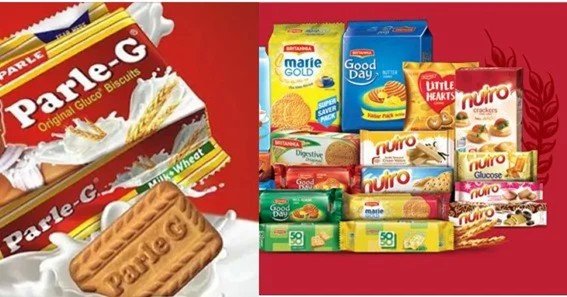The Indian snack market, particularly the biscuit segment, is highly competitive, with Britannia vs Parle being one of the most notable rivalries. Both brands have dominated the industry for decades, offering a wide range of biscuits and snacks. This article delves into the competition between Britannia and Parle, exploring their market strategies, product offerings, and who currently holds the upper hand in India’s snack market.
Comparison of Britannia and Parle: An Overview
Market Leaders in India’s Biscuit Industry
Britannia and Parle are two of the most well-known biscuit brands in India. Their products, from budget-friendly options to premium offerings, have become household names. While Britannia is known for its innovative premium biscuits, Parle’s affordability and legacy products have a stronghold, especially in rural areas.
Britannia vs Parle Market Share
According to recent reports, Parle holds a larger share of the Indian biscuit market, led by its iconic Parle-G biscuit. However, Britannia closely follows, making strides with premium product lines like Good Day, Bourbon, and NutriChoice. This ongoing Britannia vs Parle competitive analysis highlights how both brands are vying for the top spot in a fast-growing industry.
Product Range and Innovation
The comparison of Britannia and Parle reveals that Britannia tends to focus on premium and health-conscious products, introducing new flavors and ingredients to appeal to urban and health-focused consumers. In contrast, Parle continues to dominate the budget segment with classic options like Parle-G, Monaco, and KrackJack.
Britannia vs Parle: Competitive Analysis
1. Product Offerings and Innovation
When it comes to product diversity, Britannia has a broader range of offerings. It caters to different consumer segments with cookies, healthy biscuits, dairy products, and cakes. Parle, on the other hand, relies heavily on its traditional and well-established products that have a strong consumer base.
2. Brand Positioning
In the battle of Britannia vs Parle biscuits, Britannia has positioned itself as a premium brand with products that emphasize quality and health benefits. Parle’s strategy, however, revolves around affordability and nostalgia, making it a favorite among price-sensitive and traditional consumers.
3. Sales and Distribution
Both Britannia and Parle have strong distribution networks, but Parle’s reach in rural areas gives it an edge in terms of volume sales. Britannia’s focus has been on urban and semi-urban markets, where premium products have a higher demand. This creates a clear sales comparison of Britannia and Parle, with Parle leading in rural penetration and Britannia dominating urban markets.
4. Marketing Strategies
In terms of market strategies of Britannia and Parle, both brands employ different approaches. Britannia often focuses on premium advertising, with celebrity endorsements and campaigns targeting urban consumers. Parle, meanwhile, has capitalized on its legacy and affordability, focusing on mass-market advertising that resonates with a broad audience.
Biscuit Market Competition in India: Britannia vs Parle
Rural vs Urban Dominance
A significant part of the biscuit market competition in India revolves around the rural and urban divide. Parle dominates the rural market due to its affordability, while Britannia has a solid base in urban areas with its premium offerings. This rural vs urban dominance has shaped their product strategies and market focus.
Consumer Preferences and Loyalty
Consumer loyalty plays a crucial role in the battle of Britannia vs Parle. Parle’s longstanding presence in the market has garnered deep-rooted loyalty, especially for its budget-friendly biscuits. Britannia, however, has managed to carve a niche with health-conscious products and innovative flavors.
Challenges and Opportunities
Both brands face challenges in maintaining their market positions amidst changing consumer preferences. While health trends pose a challenge for Parle’s sugary biscuits, Britannia faces stiff competition from new entrants offering premium alternatives. However, the key opportunities for Britannia in FMCG lie in its ability to innovate, while Parle can further solidify its rural dominance with affordable products.
FAQ
1. What are the main differences between Britannia and Parle biscuits?
Britannia focuses on premium and health-conscious products, whereas Parle is known for its budget-friendly, traditional options like Parle-G and Monaco.
2. Who has a larger market share, Britannia or Parle?
Parle currently holds a larger market share, especially in rural areas, thanks to its affordable and widely recognized products.
3. How does Britannia’s product strategy differ from Parle’s?
Britannia’s strategy centers around premium and innovative products aimed at urban consumers, while Parle focuses on affordability and traditional favorites.
4. Why is Parle popular in rural markets?
Parle’s affordability, wide distribution, and iconic products like Parle-G make it highly popular in rural areas where price sensitivity is high.
5. What challenges do Britannia and Parle face in the Indian biscuit market?
Britannia faces competition from premium brands, while Parle must adapt to health trends and maintain its stronghold in the face of changing consumer preferences.
Disclaimer: This article is for informational purposes only and should not be taken as financial advice. Always consult a financial advisor for investment decisions.










